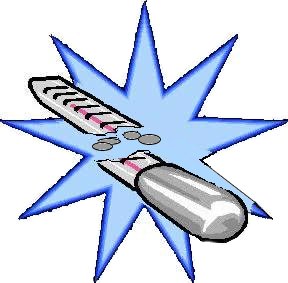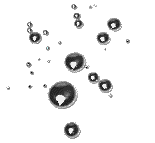|
 |
 |
What should I do if I have a mercury spill?
|
|
When liquid mercury (also known as elemental or metallic mecury)
is spilled, it forms droplets that can accumulate in the tiniest
of spaces and then emit vapors into the air. Mercury vapor in
the air is odorless, colorless, and very toxic. Most mercury exposures
occur by breathing vapors, by direct skin contact or by eating
food or drinking water contaminated with mercury.
Health problems caused by mercury depend on how much has entered
your body, how it entered your body, how long you have been exposed
to it, and how your body responds to the mercury. All mercury
spills, regardless of quantity, should be treated seriously.
|
|
There are three different procedures to address mercury spills.
|
|
|
 |
What NEVER to do
with a mercury spill
|
- Never use a vacuum cleaner to clean
up mercury. The vacuum will put mercury into the air and increase
exposure. The vacuum appliance will be contaminated and have
to be thrown away.
|
- Never use a broom to clean up mercury.
It will break the mercury into smaller droplets and spread them.
|
- Never pour mercury down a drain. It
may lodge in the plumbing and cause future problems during plumbing
repairs. If discharged, it can cause pollution of the septic
tank or sewage treatment plant.
|
- Never wash mercury-contaminated items
in a washing machine. Mercury may contaminate the machine and/or
pollute sewage.
|
- Never walk around if your shoes might
be contaminated with mercury. Contaminated clothing can also
spread mercury around.
|
Spills: Less than or equal to the
amount in a thermometer
|
Tips
|
- Remove everyone from the area where cleanup will take place.
Shut door of impacted area. Turn off ventilation system. DO NOT
allow or gain assistance from children. Remember to remove all
pets as well.
|
- Mercury can be cleaned up easily from the following surfaces:
wood, linoleum, tile and any other like surfaces. If a spill occurs
on carpet, curtains, upholstery or other like surfaces, these
contaminated items should be thrown away in accordance with the
disposal means outlined below. Only cut and remove the affected
portion of the contaminated carpet for disposal.
|
 Check
List Check
List
|
|
Items needed to clean up a small mercury spill
|
-
4 to 5 ziplock-type bags
-
trash bags (2 to 6 mm thick)
-
rubber or latex gloves
-
paper towels
-
cardboard or squeegee
-
eyedropper
-
duct tape, or shaving cream & small paint
brush
-
flashlight
- powdered sulfur (optional)
|
|
Cleanup Instructions
|
 1.- Put on rubber or latex gloves.
1.- Put on rubber or latex gloves. |
 2.-
2.- If there are any broken pieces of glass or sharp objects,
pick them up with care. Place all broken objects on a paper towel.
Fold the paper towel and place in a zip lock bag. Secure the bag
and label it as directed by your local health or fire department. |
 3.-
Locate visible mercury beads. Use a squeegee or cardboard to gather
mercury beads. Use slow sweeping motions to keep mercury from becoming
uncontrollable. Take a flashlight, hold it at a low angle close to
the floor in a darkened room and look for additional glistening beads
of mercury that may be sticking to the surface or in small cracked
areas of the surface. Note: Mercury can move surprising distances
on hard-flat surfaces, so be sure to inspect the entire room when
"searching." 3.-
Locate visible mercury beads. Use a squeegee or cardboard to gather
mercury beads. Use slow sweeping motions to keep mercury from becoming
uncontrollable. Take a flashlight, hold it at a low angle close to
the floor in a darkened room and look for additional glistening beads
of mercury that may be sticking to the surface or in small cracked
areas of the surface. Note: Mercury can move surprising distances
on hard-flat surfaces, so be sure to inspect the entire room when
"searching." |
 4.-
Use the eyedropper to collect or draw up the mercury beads. Slowly
and carefully squeeze mercury onto a damp paper towel. Place the paper
towel in a zip lock bag and secure. Make sure to label the bag as
directed by your local health or fire department. 4.-
Use the eyedropper to collect or draw up the mercury beads. Slowly
and carefully squeeze mercury onto a damp paper towel. Place the paper
towel in a zip lock bag and secure. Make sure to label the bag as
directed by your local health or fire department. |
 5.- 5.-
After you remove larger beads, put shaving cream on top of small
paint brush and gently "dot" the affected area to pick
up smaller hard-to-see beads. Alternatively, use duct tape to collect
smaller hard-to-see beads. Place the paint brush or duct tape in
a zip lock bag and secure. Make sure to label the bag as directed
by your local health or fire department. |
 6.-
OPTIONAL STEP: It is OPTIONAL to use commercially available powdered
sulfur to absorb the beads that are too small to see. The sulfur does
two things: (1) it makes the mercury easier to see since there may
be a color change from yellow to brown and (2) it binds the mercury
so that it can be easily removed and suppresses the vapor of any missing
mercury. Where to get commercialized sulfur? It may be supplied as
mercury vapor absorbent in mercury spill kits, which can be purchased
from laboratory, chemical supply and hazardous materials response
supply manufacturers. 6.-
OPTIONAL STEP: It is OPTIONAL to use commercially available powdered
sulfur to absorb the beads that are too small to see. The sulfur does
two things: (1) it makes the mercury easier to see since there may
be a color change from yellow to brown and (2) it binds the mercury
so that it can be easily removed and suppresses the vapor of any missing
mercury. Where to get commercialized sulfur? It may be supplied as
mercury vapor absorbent in mercury spill kits, which can be purchased
from laboratory, chemical supply and hazardous materials response
supply manufacturers. |
|
Note: Powdered sulfur may stain fabrics a dark color. When
using powdered sulfur, do not breathe in the powder as it can be
moderately toxic. Additionally, users should read and understand
product information before use.
If you choose not to use this option, you may want to request the
services of a contractor who has monitoring equipment to screen
for mercury vapors. Consult your local environmental or health agency
to inquire about contractors in your area.
|
 7.-
Place all materials used with the cleanup, including gloves, in a
trash bag. Place all mercury beads and objects into the trash bag.
Secure trash bag and label it as directed by your local health or
fire department. 7.-
Place all materials used with the cleanup, including gloves, in a
trash bag. Place all mercury beads and objects into the trash bag.
Secure trash bag and label it as directed by your local health or
fire department. |
 8.-
Contact your local health department, municipal waste authority or
your local fire department for proper disposal in accordance with
local, state and federal laws. 8.-
Contact your local health department, municipal waste authority or
your local fire department for proper disposal in accordance with
local, state and federal laws. |
 9.-
Remember to keep the area well-ventilated to the outside (i.e., windows
open and fans running) for at least 24 hours after your successful
cleanup. Continue to keep pets and children out of cleanup area. If
sickness occurs, seek medical attention immediately. EPA's Mercury
Web site presents information on health
effects related to exposures to vapors from metallic mercury.
For additional information on health effects, the Agency for Toxic
Substances and Disease Registry (ATSDR) provides a Mercury
Fact Sheet that also presents information on health effects related
to exposures to vapors from metallic mercury. 9.-
Remember to keep the area well-ventilated to the outside (i.e., windows
open and fans running) for at least 24 hours after your successful
cleanup. Continue to keep pets and children out of cleanup area. If
sickness occurs, seek medical attention immediately. EPA's Mercury
Web site presents information on health
effects related to exposures to vapors from metallic mercury.
For additional information on health effects, the Agency for Toxic
Substances and Disease Registry (ATSDR) provides a Mercury
Fact Sheet that also presents information on health effects related
to exposures to vapors from metallic mercury. |
| Recommendation: If there
are young children or pregnant women in the house, seek additional
advice from your local or state health or state
environmental agency. |
Back to Top
Spills: More than the amount
in a thermometer
Caution:
The general public can clean up small mercury spills no greater
than the amount contained in a thermometer from flat surfaces.
If you estimate your mercury spill to be greater than the amount
in a thermometer, isolate the contaminated area and call your
local or state health or state
environmental agency.
|
Back to Top
Spills: Greater than One Pound
(Two Tablespoons)
 |
Any time one pound or more of mercury is released to
the environment, it is mandatory to call the National
Response Center (NRC). The
NRC hotline operates 24 hours a day, 7 days a week. Call (800) 424-8802.
Note that because mercury is heavy, only two tablespoons of mercury
weigh about one pound |
Back to Top
State Links
 |
Many states provide more detailed step-by-step
instructions on how to contain a mercury spill and, in the case of
small spills, how to clean it up yourself, as well as on available
cleanup contractors and proper disposal of collected mercury. Examples
are: |
Additional Resources
Mercury Response Guidebook
The Mercury Response Guidebook, by EPA’s Emergency
Response Team and EPA Region
5, is designed to assist emergency and remedial professionals coordinate
and clean up indoor mercury spills. The principles in this guidebook can
also be used at other mercury-contaminated sites.
Contents:
Attachments:
|










